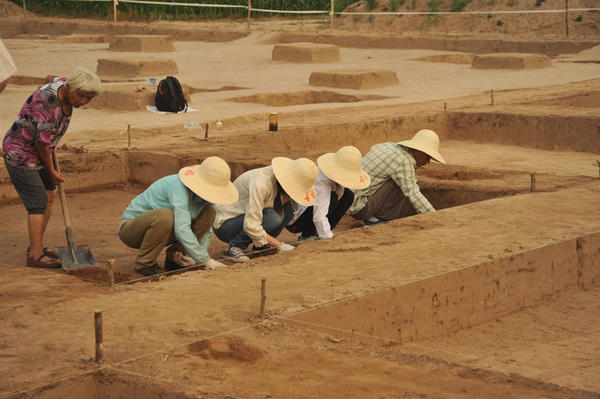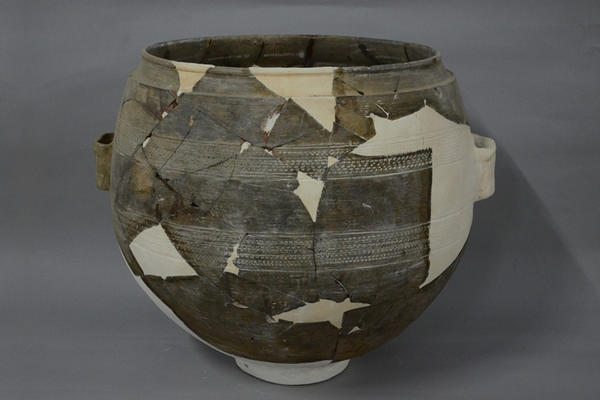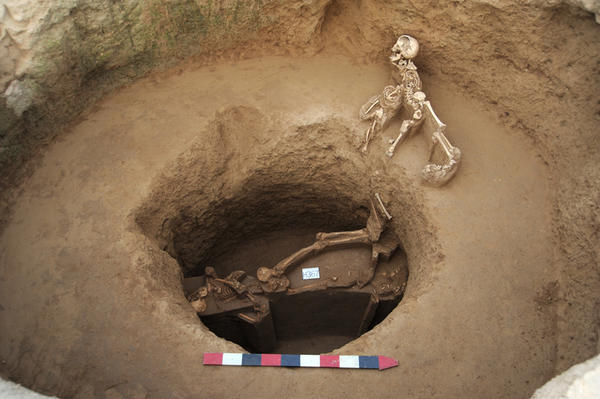Famous for the remains of three ancient cities in different periods which are stacked on top of one another, the Dongzhao Site in Zhengzhou city of Henan province was included on the list of China's top 10 archaeological finds of 2014.
Click on the video
The sites and ruins of the Xia (2070 BC-1600 BC) and the Shang (1600 BC-1046 BC) dynasties are densely distributed in northwestern suburban Zhengzhou, one of the key areas for many important academic issues related to China's Bronze Age. To explore the formation and development of the early states in the Central Plains, a team led by the Institute of Cultural Relics and Archaeology of Zhengzhou and the School of Archaeology and Museology of Peking University has conducted large-scale fieldwork at the Dongzhao site since 2012 with relics of the late Longshan Culture (around 2500 BC-2000 BC), the Xinzhai Phase (around 1870 BC-1720 BC), the Erlitou Culture (around 1735 BC-1530 BC), the Erligang Culture (around 1600 BC-1400 BC), the Western Zhou Dynasty (1046 BC-771 BC) and the Eastern Zhou Dynasty (770 BC-256 BC) discovered.
Because of its long-lasting and complete archaeological cultures, the site is rare of its kind in the Central Plains. At the remains of three ancient cities in different periods which are stacked on top of one another, many important cultural relics were unearthed. The relics unearthed from the small and the medium cities are related to the Xia Dynasty, while those discovered from the large city belong to the Eastern Zhou Dynasty.
Archaeologists work at the Dongzhao Site. [Photo provided to Henan Daily]
Located in the northeast of the site, the small city is basically square in shape with an area of 22,000 square meters. First built in the early Xinzhai Phase (the early Xia Dynasty), the city was completely abandoned in the first stage of the Erlitou Culture (the middle Xia Dynasty). Currently, only one city ruin of the Xinzhai Phase was discovered at the Xinzhai Site in Xinmi of Zhengzhou, so it still remains controversial. The city ruin discovered at the Dongzhao Site is the second of its kind, and the first in the north of the Songshan Mountain.
Outside the southern city wall discovered more than 40 regular distributed ash pits. All of them are round in top and similar in size with 5 or 6 in a group, whose filling is mostly red clay with dense texture. Pig skeletons, tortoise shells and human bones were found in some pits. Some experts believe that such pits were used for storage, while others think they were related to sacrifices. It was the first time that those special remains of the Xinzhai Phase (the early Xia Dynasty) were found with great academic values.
A pottery ware unearthed at the Dongzhao Site. [Photo provided to Henan Daily]
Located in the middle of the site, the medium city is basically trapezoidal in shape with an area of 90,000 square meters. First built in the second stage of the Erlitou Culture, the city was completely abandoned in the fourth stage of the Erlitou Culture (the late Xia Dynasty). Since there are not many city ruins of the Erlitou Culture at present, the city ruins at the Dongzhao Site are indispensable for the study of the regional settlement form and geopolitical structure.
Two special phenomena were also mentioned by Zhang Jiaqiang who led the excavation.
First, a bone pit of the second stage of the Erlitou Culture was discovered. The bones in the pit are shoulder blades with orderly burn marks, belonging to almost 20 head of cattle. Each bone is about 30 centimeters long. Among all the bone pits of the Erlitou Culture, such a pit has the largest number of bones, which is of great significance for the study of the divination system in the Xia Dynasty, even the whole pre-Qin period (before 221 BC). Second, a child's bones were also found within the wall of the medium city, believed to be related to the ancient sacrifice rites, which is not seen in other sites of the Erlitou Culture.
H367 (the Xinzhai Phase). [Photo provided to Henan Daily]
As for the importance of the Dongzhao Site in the study of the culture of the Xia Dynasty and the site's relationship with the Erlitou Site (capital site of the middle and late Xia Dynasty), Zhang said that the Dongzhao Site must have been a very important place in the Xia Dynasty because the remains of the early and late Xia Dynasty were found here with city ruins discovered. At the Erlitou Site, the capital site of the middle and late Xia Dynasty, palace ruins, bronze wares, jades, etc., were discovered, while at the Dongzhao Site, city ruins were unearthed, but there were not many bronze wares and jades, which indicates that it might be an important military base. (Chinese source: Henan Daily App Reporter: Zhang Tiyi Hu Chunna Translator: Zhao Hanqing Video: Wang Junyi Proofreader: Chen Xingjie Bai Yujie)
Related reports
The Xia Dynasty Travel Episode V The Puchengdian Site: Two Ancient City Ruins Discovered
The Xia Dynasty Travel Episode VI The Xinzhai Site in Xinmi: The First Capital of the Xia Dynasty?
The Xia Dynasty Travel Episode VII The Yuzhuang Site: Unveiling the Noble Life 4,000 Years Ago
The Xia Dynasty Travel Episode IX The Erlitou Site in Yanshi: A 'Dynasty' in a Small Village





